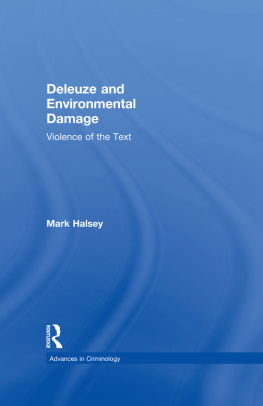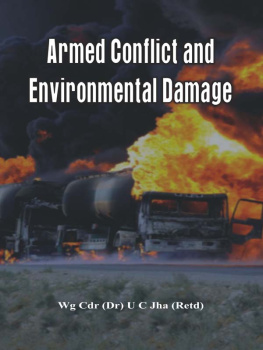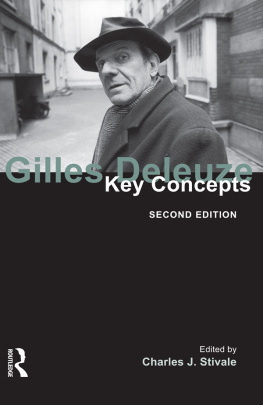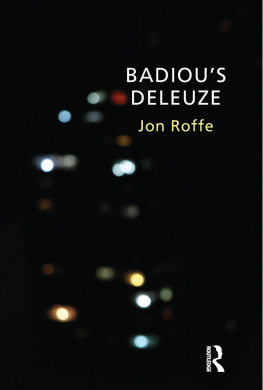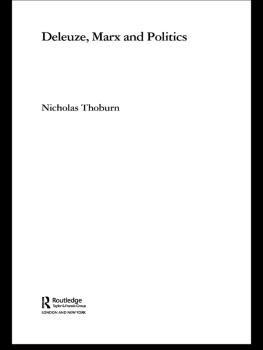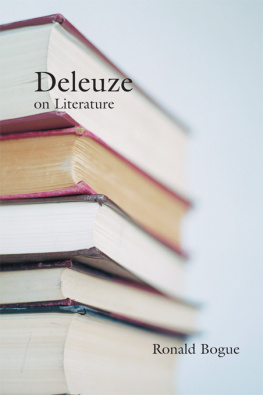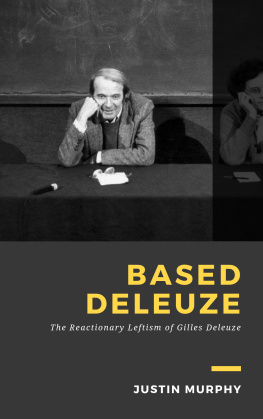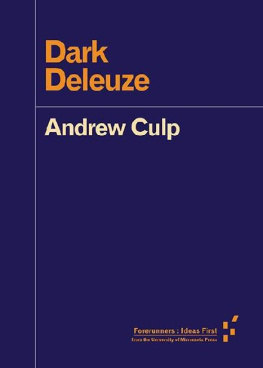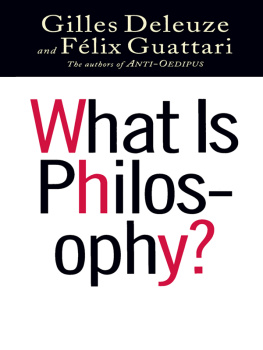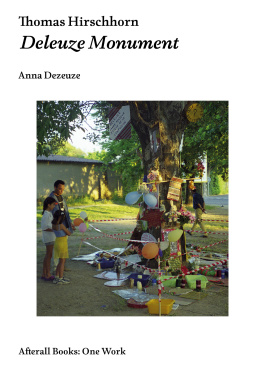Mark Halsey - Deleuze and Environmental Damage
Here you can read online Mark Halsey - Deleuze and Environmental Damage full text of the book (entire story) in english for free. Download pdf and epub, get meaning, cover and reviews about this ebook. year: 2006, publisher: Routledge, genre: Romance novel. Description of the work, (preface) as well as reviews are available. Best literature library LitArk.com created for fans of good reading and offers a wide selection of genres:
Romance novel
Science fiction
Adventure
Detective
Science
History
Home and family
Prose
Art
Politics
Computer
Non-fiction
Religion
Business
Children
Humor
Choose a favorite category and find really read worthwhile books. Enjoy immersion in the world of imagination, feel the emotions of the characters or learn something new for yourself, make an fascinating discovery.
- Book:Deleuze and Environmental Damage
- Author:
- Publisher:Routledge
- Genre:
- Year:2006
- Rating:3 / 5
- Favourites:Add to favourites
- Your mark:
- 60
- 1
- 2
- 3
- 4
- 5
Deleuze and Environmental Damage: summary, description and annotation
We offer to read an annotation, description, summary or preface (depends on what the author of the book "Deleuze and Environmental Damage" wrote himself). If you haven't found the necessary information about the book — write in the comments, we will try to find it.
Mark Halsey: author's other books
Who wrote Deleuze and Environmental Damage? Find out the surname, the name of the author of the book and a list of all author's works by series.
Deleuze and Environmental Damage — read online for free the complete book (whole text) full work
Below is the text of the book, divided by pages. System saving the place of the last page read, allows you to conveniently read the book "Deleuze and Environmental Damage" online for free, without having to search again every time where you left off. Put a bookmark, and you can go to the page where you finished reading at any time.
Font size:
Interval:
Bookmark:
Series Editor: David Nelken
Alessandro De Giorgi
Fiona Haines
Edited by Wilma Smeenk and Marijke Malsch
Edited by Amy Gilman Srebnick and Ren Lvy
Eamonn Carrabine
Edited by Richard Hil and Gordon Tait
Edited by Dermot Feenan
Edited by Pamela Cox and Heather Shore
Edited by Joshua D.Freilich, Graeme Newman, S.Giora Shoham and Moshe Addad
George Pavlich
Edited by David Nelken
University of Melbourne, Australia and Flinders University of South Australia, Australia

2 Park Square, Milton Park, Abingdon, Oxon OX14 4RN
711 Third Avenue, New York, NY 10017, USA
Product or corporate names may be trademarks or registered trademarks, and are used only for identification and explanation without intent to infringe.
Halsey, Mark
Deleuze and environmental damage. -(Advances in
criminology)
1.Deleuze, Gilles -Knowledge -Environmental law
2.Environmental law -Philosophy
I.Title
344'.046
Halsey, Mark.
Deleuze and environmental damage: violence of the text /by Mark Halsey.
p.cm. --(Advances in criminology)
Includes bibliographical references and index.
ISBN 0-7546-2491-9
1. Offenses against the environment. 2. Environmental degradation. 3. Ecology -
Philosophy. 4. Human ecology. 5. Criminology. 6. Deleuze, Gilles. I. Title. II.
Series.
364.1'8--dc22
- ii
- Halsey, M. (2004) 'Against "Green" Criminology', British Journal of Criminology, Vol. 44. No. 6,pp. 83353, by permission of Oxford University Press;
- Halsey, M. (2005) 'Ecology and Machinic Thought: Nietzsche, Deleuze, Guattari', Angelaki: Journal of the Theoretical Humanities, Vol. 10, No. 3, pp. 3356, by permission of Routledge;
- Halsey, M. (2004) 'Environmental Visions: Deleuze and the Modalities of "Nature"', Ethics & the Environment, Vol. 9, No. 2, pp. 3364, by permission of Indiana University Press.
Font size:
Interval:
Bookmark:
Similar books «Deleuze and Environmental Damage»
Look at similar books to Deleuze and Environmental Damage. We have selected literature similar in name and meaning in the hope of providing readers with more options to find new, interesting, not yet read works.
Discussion, reviews of the book Deleuze and Environmental Damage and just readers' own opinions. Leave your comments, write what you think about the work, its meaning or the main characters. Specify what exactly you liked and what you didn't like, and why you think so.

